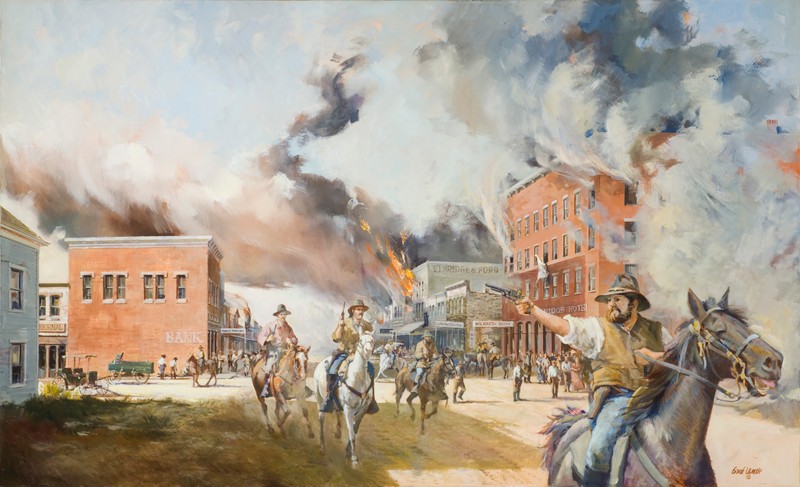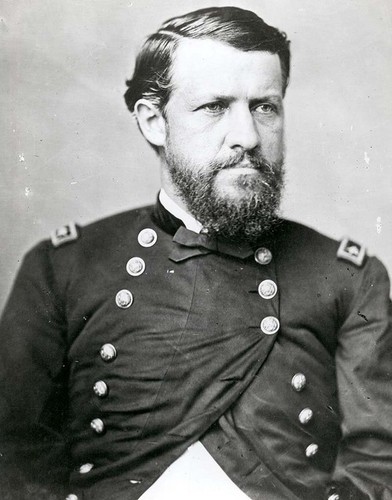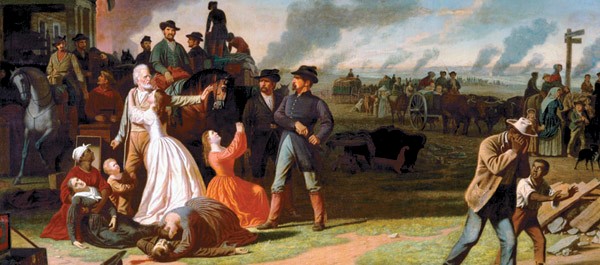Union Women's Prison Marker
Introduction
Text-to-speech Audio
The Union Women’s Prison Marker is located off 1425 Grand Boulevard in downtown Kansas City, Missouri. The marker was erected to honor those lost and injured after the building collapsed on August 14, 1863. The building housed female prisoners arrested under Union Brigadier General Thomas Ewing, Jr. as part of a strategy in order to subside Confederate guerrilla warfare along the Missouri-Kansas border. In 1863, Kansas City was named the headquarters of the newly-created U.S. Army District of the Border, which was charged with controlling the Confederate guerrilla insurgency along the Missouri-Kansas border. The women were accused of aiding the Confederate guerrillas, known as Bushwhackers. The 17 accused women were housed in the top two floors of a seven-year-old three-story building owned by renowned Missouri artist George Caleb Bingham. Union soldiers and officials worked in offices on the first floor. Four women were killed, and a number were injured. While it is unknown why the building failed, it is noted that Union officials removed support columns and bricks to make room for a storage cellar.
Images
Union Prison Collapse Marker

Ernst Ulmer painting of Lawrence Massacre

General Thomas Ewing

George Caleb Bingham painting of Order No. 11

Backstory and Context
Text-to-speech Audio
The Union army in the Missouri-Kansas border region experienced its fair share of difficulties with pro-Confederate forces, but they were particularly frustrated by the violence of local guerrilla bands. Union General Thomas Ewing, Jr., the commander of the newly-created District of the Border, was charged with stopping the frequent cross-border raids of pro-Union Jayhawker and pro-Confederate Bushwhacker forces. Historian LeeAnn Whites explains that guerrilla warfare tactics were not the same as those of traditional war. [1] “Guerrilla war, fought anywhere, on any terrain, and at any time, opens the prospect that women and children will be caught haplessly in the crossfire between competing groups of men.” Whites further explains that while the men might have been the front-facing figures of guerrilla warfare, the women were doing behind-the-scenes work, as part of what she calls the “supply line.” [2]
Gen. Ewing quickly recognized that civilian households supported the Bushwhackers by providing them with food, clothing, horses, and military intelligence. Ewing decided to arrest and banish from the region families who were known to support the guerrilla. He sought and was granted authorization from the St. Louis headquarters of the Department of the Missouri, but he put the plan into motion before officially issuing the order. He began by arresting women who were accused of aiding Bushwhackers; some were arrested in public settings, and others were taken from their homes. While some women were found with resources such as lead, gunpowder, and suspicious amounts of cash, others were arrested simply for being associated with Bushwhackers and held as prisoners. Historian Joseph Beilein says one of the most important ways these women contributed to the cause was by creating [3] “guerilla shirts” for their husbands, boyfriends, and the like.[4] “The shirts were emblematic of the guerillas’ style more generally, the greatest influence on which was the look of the frontier hunters who had straddled the fringes of the white and Indian worlds since very early in the European settlement of the Americas." The women were not granted bond or bail and sat in the Kansas City prison awaiting trial in St. Louis. There were multiple prisons surrounding the Kansas City area, but the 1409 Grand Ave location was a tavern transformed to hold approximately 20 women.
The building, already in poor condition, underwent mild renovation in order to house the women and create offices for Union soldiers. Kansas City native and future mayor Elijah M. McGee said in an affidavit after the collapse that beams [5] “had been cut away from the girders or center beam” and other forms of support [6] “had already sunk some two or three feet." Although the building was inspected on August 3 and several structural deficits were noted, no action was taken. On the afternoon of August 13, the building collapsed, killing four women instantly and one more days later due to her injuries. Many more were injured. One of the women killed was Josephine Anderson, the teenage sister of infamous Bushwhacker William “Bloody Bill” Anderson. Rumors ran rampant that this tragic event was no accident. In the days after the building collapse, Ewing issued General Orders No. 9 and 10, which called for freeing and arming local enslaved people and evicting relatives of known guerrillas from the border region. This series of events was, in a sense, the final straw for the Bushwhackers, who demanded immediate action. [7] “We could stand no more… innocent and beautiful girls had been murdered in a most foul, brutal, savage and damnable manner. We were determined to have our revenge,” said John McCorkle, who lost his sister in the collapse.
The Bushwhackers, led by Bill Anderson and William Quantrill, began hosting meetings across farms in Missouri to discuss retaliation. On August 21, 1863, eight days after the prison’s collapse, Quantrill led the Bushwhackers to Lawrence, Kansas, and killed over 150 men and boys in under two hours. General Ewing had become increasingly frustrated with trying to control the Missouri guerrillas. This event prompted him to issue General Order No. 11 on August 25, 1863, four days after the Lawrence Massacre. The order stated that all Missouri citizens living in Cass, Bates, Jackson, and the northern part of Vernon counties had fifteen days to vacate their homes. Residents who could prove their loyalty could move within a mile of the Union garrisons that were located in the northern part of the military district. Ewing believed that this harsh order would finally put an end to the violent guerrilla warfare that plagued the Missouri-Kansas border.
The collapse of the Union Women’s Prison in Kansas City is one of a series of tragic events that eventually led to the conclusion of guerrilla warfare along the Missouri-Kansas border. As stated on the marker: [8] “A tragedy here and Order No. 10 were blamed for the Lawrence Massacre.” Ewing’s orders following the prison collapse made it difficult for guerrillas to regain control of the area, weakening their support and resources. This left them no choice but to abandon the area.
The building collapse also may have led artist George Caleb Bingham to paint one of his most well known paintings, Martial Law or Order No. 11. Although he served in the pro-Union state government in Jefferson City, Bingham was enraged by Ewing's treatment of Missouri civilians. He also likely felt he was implicated in the tragedy due to his ownership of the building. Bingham painted the scene of Union soldiers violently evicting a Jackson County family in part to discredit Ewing and undermine his postwar political aspirations.
This event was a pivotal moment in the Civil War history of the region and was aptly dedicated by the marker located in downtown Kansas City.
Sources
[3] [4] Beilein, Joseph M. “The Guerrilla Shirt: A Labor of Love and the Style of Rebellion in Civil War Missouri.” Bleeding Kansas, Bleeding Missouri, University Press of Kansas, pp. 169–186.
“Civil War on the Western Border: The Missouri-Kansas Conflict, 1854-1865.” General Orders, No. 10 | Civil War on the Western Border: The Missouri-Kansas Conflict, 1854-1865, Kansas City Public Library, civilwaronthewesternborder.org/islandora/object/civilwar%3A2140#:~:text=10%20from%20the%20Department%20of,duty%2C%20desertion%2C%20and%20mutiny.
Dennis, Clarence. “CuriousKC: How a Kansas City Women’s Prison Collapse in 1863 Fueled Quantrill’s Raid of Lawrence.” Flatland, Kansas City PBS, 5 Oct. 2020, flatlandkc.org/curiouskc/question-everything/questions-answered/curiouskc-how-a-kansas-city-womens-prison-collapse-in-1863-fueled-quantrills-raid-of-lawrence/.
Grubbs, Brian. “A Desolated Country: The Union Jail Collapse, Lawrence Massacre, and General Order No. 11.” Show Me Missouri, Show Me Missouri, 5 Oct. 2021, showmemo.org/war-conflict/a-desolated-country-the-union-jail-collapse-lawrence-massacre-and-general-order-no-11/.
O’Bryan, Tony. “Civil War on the Western Border: The Missouri-Kansas Conflict, 1854-1865.” Collapse of the Union Women’s Prison in Kansas City | Civil War on the Western Border: The Missouri-Kansas Conflict, 1854-1865, Kansas City Public Library, civilwaronthewesternborder.org/encyclopedia/collapse-union-women%E2%80%99s-prison-kansas-city.
[5] [6] [7] Telegraph, Martin City Telegraph. “The Collapse of a Women’s Prison 154 Years Ago Led to the Bloody Lawrence Massacre.” South Kansas City News - The Martin City Telegraph, Martin City and South KC: The Telegraph, 25 Aug. 2017, martincitytelegraph.com/2017/08/25/the-collapse-of-a-womens-prison-154-years-ago-led-to-the-bloody-lawrence-massacre/.
[8] The Historical Marker Database. “Union Prison Collapse Historical Marker.” HMdb.Org, CeraNet Cloud Computing, 10 Feb. 2023, www.hmdb.org/m.asp?m=42056.
[1] [2] Whites, LeeAnn. “Forty Shirts and a Wagonload of Wheat: Women, the Domestic Supply Line, and the Civil War on the Western Border.” The Journey of the Civil War Era, vol. 1, Mar. 2011, pp. 58–78. 1, https://doi.org/10.1353/cwe.2011.0021 For additional information about this article Access provided by University of Missouri - Kansas City (24 Jun 2013 13:56 GMT) http://muse.jhu.edu/journals/cwe/summary/v001/1.1.whites.html.
https://civilwaronthewesternborder.org/encyclopedia/collapse-union-women%E2%80%99s-prison-kansas-city
https://www2.ljworld.com/news/2013/aug/18/bloody-predawn-raid-shaped-lawrences-history/
https://www.kshs.org/p/thomas-ewing-jr-papers/14018
https://www.historynet.com/george-caleb-binghams-order-no-11/
